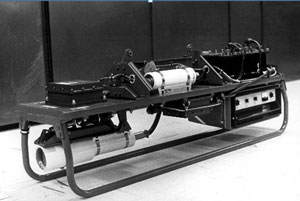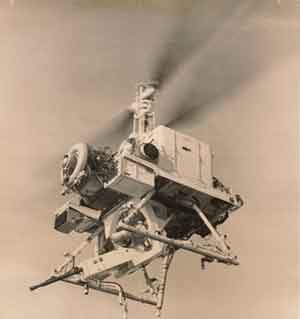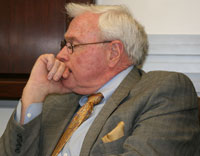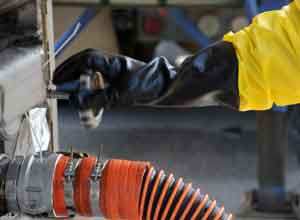UAV Lessons Learned: Coping With Disruptive Technologies
By C.J. Pappas
Constantine Pappas is starting a series on the development of the UAV environment in the Department of Defense as a new regular SLD contributor.
***
This is the first of a series of anecdotal vignettes of the development of the UAV (now called UAS) environment in the Department of Defense. Subsequent articles will deal with:
- Pioneer: How The Program Survived A 27% Readiness Factor
- Small drones: A Fractionated Market That Enabled Innovation with No Adult Supervision
- Predator: A Success Story in Creating a Market
- Global Hawk: Managing Risk/Reward
Many recent attitudes reflect the first flight of an unmanned vehicle in 1783. As Jim Winchester writes in The Timeline of Aviation:
“An unmanned test balloon flew from Paris north to Gonesse, a village now situated between Charles de Gaulle and Le Bourget airports. There it suffered the indignity of being attack and destroyed by bewildered peasants.”
A fate suffered by many recent UAV projects…
This series addresses the difficulties of introducing a Disruptive Technology in the Defense community and to provide lessons learned for program managers, operators and decision makers. Wikipedia states that: “Disruptive Technology and Disruptive Innovation are terms used in business and technology literature to describe innovations that improve a product or service in ways that the market does not expect, typically by being lower priced or designed for a different set of consumers. Disruptive technologies are particularly threatening to the leaders of an existing market, because they are competition coming from an unexpected direction.”
The perspectives presented in these articles range broadly across four decades of success and failure with this disruptive technology.
[slidepress gallery=’qh50-slideshow’]
Credits: The photos of Destroyer, Short Final and Snoopy are U.S. Navy; the ones of the Night Panther and Armed QH-50 are DARPA; and the one of Jeep Control station is Gyrodyne.
Navy’s First Fleet-Fielded UAV System: Successful Operations, Failure In Management
Why does a program that performs 400 percent better than its Technical Development Plan requires, has been fielded on over 100 ships, delivered under schedule and under budget, and performs with a weapons systems effectiveness factor that is 12 percent higher than its nearest competitor get terminated?
Users and Buyers Have Different Goals
With the Cold War in full hue and cry and a dramatic Soviet submarine building program presenting a major threat, Anti-Submarine Warfare (ASW) was a primary strategic factor for the US Navy in the 1950s and 1960s. The Air Force was held in abeyance from ASW by congressional edict, preserving ASW as the Navy’s unique mission.
Within the Navy, the aviation and surface platform barons and their communities were locked in mortal combat for ascendency in the ASW mission role. While the US submarine community was focused on the “silent service” role, the backroom intelligence relationships with the aviation community were very strong. The aviators were effective in collecting Soviet sub signatures for use by the “silent service.” These intelligence community relationships created a strong interwoven link between subs and aviation.
The surface community “black shoes” viewed ASW as one of their three prime warfare missions, the other two mission areas being Anti-Air Warfare and Anti-Surface Warfare. The competition between the communities was fierce. It reflected competition in a zero-sum game where careers, promotions, personalities, and egos were involved in a winner-loser environment.
Admiral Arleigh (“31 Knot”) Burke, a surface sailor, served from 1955-1961 as Chief of Naval Operations (CNO) and became the protagonist for the Drone Anti-Submarine Helicopter (DASH) to fill the need for a surface ship with a long-range ASW weapons delivery capability. Burke was willing to take high risks like DASH in order to restore the surface Navy’s position within the Navy’s air, sub, and surface hierarchy and he had the personal clout to push through the changes that he felt the Navy needed – a four star change-agent.
During the late 1950s, the Marine Corps established a competition for a one-man helicopter for troop operations in a nuclear environment. The coaxial Rotocycle, developed by the Gyrodyne Company of Long Island, NY, won the competition. Admiral Burke observed the competition and saw the machine as the perfect vehicle to extend the range of surface ship weapons delivery beyond that of the Rocket Assisted Torpedo (RAT) and the follow-on Anti-Submarine Rocket (ASROC).
At Burke’s insistence, the Navy initiated the DASH program with Gyrodyne, owned by Peter J. Papadakis, a flamboyant Greek immigrant.
Since DASH was a flying machine, the Bureau of Aeronautics (BUAER, now NAVAIR) assumed the responsibility for buying, fielding, and supporting the air vehicles that would be flying off destroyers in support of the surface community missions. BUAER designated the QH-50 DASH as a “naval aircraft,” a decision that would prove to be the death knell for the program.
The Naval Ship Systems Command (now NAVSEA) was responsible for implementing the Fleet Rehabilitation and Modernization (FRAM) program. Eventually, over 100 ships were outfitted with DASH as an operational mission system in competition with the naval aviation community. This was the first time that the aviation and the surface ship community had interaction on a joint program other than aircraft carriers. The cultures and vocabularies were different and how they viewed their mission areas were in direct competition.
This would not be the last time unmanned systems would be in this situation.

What Was the DASH System
The QH-50 air vehicle used the Boeing T50-BO-8, and, later, the T50-BO-12 heavy fuel gas turbine engines. The T-50-BO engines were also used in mine sweeping boats with the designation of LM-XX. Two QH-50 air vehicles were carried aboard a FRAM destroyer and secured in the hangar. Each vehicle could be rolled out and spotted for flight operations. The deck handling equipment was designed to ensure positive control of the QH-50 during all deck movement and could be rigged and un-rigged in about three minutes by the QH-50 detachment personnel. The actual time to launch from secured for sea in the hangar to lift off was about seven minutes. The hangar was alsoused for performing all organizational maintenance.
In addition to the hangar, the ship had an installed Ground Control System (GCS) in a separate small equipment room, generally located on the main deck below the hangar spaces. Full redundancy was provided by a “mix and match” dual transmitter, dual antenna, and dual coder/decoder GCS capability. The primary control station for the entire system was on the flight deck under the control of the DASH Officer, the officer-in-charge of a detachment. There was a secondary control station in CIC where the ship’s CIC Officer could control the air vehicle at extended ranges by using plots of the submarine target and the UAV on the NC-2 plotter. A separate storeroom used only for the DASH parts completed the ship facilities required to support the UAV system.
The QH-50 was a very benign air vehicle for payload integration. Since the QH-50 was designed to carry two torpedoes (each weighed 450 lbs) side by side and to release one at a time, the air vehicle was relatively insensitive to lateral shifts of the center of gravity (CG). The digital control system had several spare switch functions and with three hard points on the airframe, and up to 21 KVA of airborne power available, it was possible to interface many packages with the QH-50. The simple engine interface and the over-capacity transmission enabled the system to have a significant built-in load carrying capability of about 1,100 lbs without a great deal of concern for CG position.
Using heavy fuel (JP-5), DASH could remain airborne for about 1.75 hours carrying two MK-44 or one MK-46 torpedo out to a convergence zone range of about 30 miles. The range was limited by the radar return from the drone. While a DME transponder capability was available, BUAER declined to invest in the $2,500 per unit and many QH-50 were lost due to loss of radar tracking as it flew over the radar horizon. The operating altitude of the DASH was limited electronically to 1,000 feet because that height was thought sufficient for torpedo deployment.
 Dash On Short Final (credit: U.S. Navy)
Dash On Short Final (credit: U.S. Navy)
“Using heavy fuel (JP-5), DASH could remain airborne for about 1.75 hours
carrying two MK-44 or one MK-46 torpedo out to a convergence zone range of about 30 miles.”
The 5 hour endurance, shown in this table, was attained through the use of saddle tanks for special mission purposes.
DASH Physical and Performance Characteristics
The normal complement for the DASH was a five person detachment consisting of an Ensign or LT(jg) with no prior aviation experience and a skilled enlisted crew of two aviation machinists and two avionics technicians. The ship provided two nono-rated plane handlers. The detachments were formed out of VU-3 and VC-6 personnel for PAC and LANT units, respectively. The DASH personnel normally had no ship duties under way and could spend their entire time on maintenance and preparation for flight.
The personnel situation deteriorated over time. Instead of highly trained enlisted aviation ratings, the DASH detachments were made up of lower skilled ratings, which became reflected in the performance and readiness of the system.
Training was performed through the existing Navy infrastructure. Flight training for the DASH officer consisted of about 8-12 hours of actual flight time and about 6-8 weeks of classroom instruction for both the officers and enlisted personnel.
DASH Experiences Barriers to a Disruptive Technology – Perception Becomes Reality
With Admiral Burke planning to retire and Admiral George Anderson, a Naval Aviator, taking his place as CNO, the seven year development period initially planned for the DASH was truncated to three and the DASH was placed into the Fleet in 1963, essentially using the fleet as a development and test organization.
Surface ship Commanding Officers did not like DASH. Because DASH had been designated a naval aircraft, any time a DASH was lost, a full OPNAV investigation was held to determine the reasons. The surface ship Commanding Officers were forced to hold these special hearings when a DASH was lost and to file OPNAV reports. Since the surface navy tended to eat their young, several CO’s careers were derailed by having letters of censure placed in their file because a DASH crashed. In short, flying DASH was risky to careers.
Hence, the situation was one where the users of DASH, the surface ship drivers, would not use the system due to this high risk. The aviation community that provided support for the DASH would not permit DASH to fly when manned aircraft were operating, and the naval aviation acquisition community was actively campaigning to kill DASH so Light Airborne Multi-Purpose Systems (LAMPS) could fly.
The key used by opponents of the DASH was the number of DASH losses. If the loss rate In this area, the surface and aviation communities were in harmony. The surface community knew that a manned helo would belong to a squadron and the ship‘s CO need only continue the ships normal routine. If anything happened, it would be the squadron CO’s responsibility. Hence no career risks.
Key facilitators involved in the anti-DASH campaign were the prime contractors. In addition to the normal advertising blitz, lobbying congressional support, the contractors discovered that their Naval Reserve officers on their staffs could be put to good use for the program when these individuals were on active duty. The active duty reserve officers were known to copy brochures and submit them to various professional naval publications as stories of value to the sailors. Bad news travels well and the DASH blemishes were continually exposed.
In 1966 the steady drumbeat of criticism, mainly from the Navy itself, forced the Secretary of Defense to defund the program in the 1967 budget. However, the DASH program had sufficient resources to continue for many years, in fact until 1971 when the program was directed to stop and the 750 DASH billets were redirected to the emerging LAMPS program.
Reality Does Not Mean the DASH Will Be Saved – Dead Man Walking
The Navy’s Technical Development Plan called for a mean time between loss (MTBL) of 1 loss for every 24 hours of flight time. The actual Fleet MTBL was 100 flight hours (LANTFLT) and 117 flight hours (PACFLT). Several unique US operations had a MTBL of 425 hours and the Japanese Maritime Self-Defense Force had an MTBF of 650+hours.
Goodness had nothing to offer in the way of saving a disruptive technology. There were many bright lights for DASH in the fleet. These were the 20% that do the 80% of the lifting. The table below summarizes some of the higher standards of fleet performance, contrary to the drumbeat of antipathy.
DASH Fleet Performance

Worthy of note is the comment regarding transit to YANKEE station and SNOOPY flight hours conducted in 1968. SNOOPY was an interesting non-program. While most of the Navy knew of DASH as the torpedo delivery system, fewer knew that Project Snoopy had been initiated to provide reconnaissance and gunfire support spotting capability in Vietnam. Six SNOOPY video packages were made up that were completely bolt-on self-contained systems to be carried on one of the three stores stationed on the QH-50. These packages provided omni-directional real time video data to the ship or to any station with a video receiver capability. On certain missions, once the QH-50 had lifted off and was inbound to the target, control of the QH-50 was passed to a manned helo that was equipped with a portable QH-50 control system. The manned helo extended the effective range of the QH-50 well beyond the normal shipboard maximum control range of 50 miles and was a first for UAV-manned aircraft interface. What made this feasible was the simplicity of interfacing the airborne DASH electronics.
The figure below provides a conceptual view of the project.
SNOOPY Con Ops
Nuclear monitoring for Project GREELEY was another capability. The project worked so well that DOE requested transfer of QH-50 from the Navy. The Navy declined.
Meanwhile, DARPA’s Dick Cesaro initiated the Night Gazelle and the Night Panther projects. Both of these projects were highly successful. These and several other projects were so far ahead of anything else in the DoD pantheon of favorite projects that eventually Dick was invited to leave DARPA. While the Egyptian Goose and similar projects (with new names) are now still operational, DASH died. Night Panther was the DARPA Weapons Demonstration program using the QH-50 Platform.

The stability of the QH-50 in flight offered an outstanding opportunity for DARPA to extend the state of the art in controls and weapons delivery platforms. Consequently, DARPA launched the QH-50 NITE GAZELLE program to outfit the QH-50 as a weapons platform. When carrying weapons that required aiming, a large U-Mount platform provided the extreme stability required for precise weapon aiming. A good example of one of the more sophisticated projects is the QH-50 with a 5-hour endurance carrying a DU .50 caliber gun with a LLLTV and a contrast tracker (shown in the picture on the left).
The three stores station, the payload weight carrying capacity, and the use of Practice Multiple Bomb Racks (PMBR’s) gave the system a high degree of weapons utilization flexibility as shown in the photograph below.
 Armed Q-50 : Weaponeering DASH (credit: DARPA)
Armed Q-50 : Weaponeering DASH (credit: DARPA)
The various capabilities of the QH-50, its operating experience and ability to be upgraded had no influence on the final decision to terminate the program. Worthy of note is that more than 30 years after termination of the program, the QH-50 was being flown by the Navy and the Army for T&E purposes.
It is important to examine why the program was rejected by the various communities regardless of the “goodness” of the program.
Barriers to Disruptive Technology and Lessons Learned
Let’s examine some of the barriers and lessons learned.
———-
***Posted on May 12th, 2010









